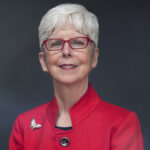Myths are beliefs that while widely held are not true. There are so many myths about aging that an entire book could be filled. Below we discuss some old and some new myths that you may have heard in your professional and personal circles. See if you recognize them. And here is information to reset the myths with facts.
Myth 1
Older adults would use digital technology such as computers, smartphones, TV remote controls, apps, etc. more if manufacturers were to make more ergonomic “fixes” such as bigger buttons, crisper and bigger fonts, louder audio, and less complicated remotes.
To date, this focus on adaptations to digital technology that compensate for functional declines such as hearing, vision, and motor skills has met with only partial success. This lack of success is due to a mismatch in mental models of the older adult’s thinking about how devices work, a model that each person develops in their early maturity based on their experiences with the technology of the times. For example, the silent generation (born 1930 to 1944) and the baby boomers (born 1945 to 1964) were exposed to electro-mechanical and analog devices (e.g. vacuums, tape recorders, etc.); turn a switch and the device springs into action. But today’s devices must be navigated through multiple screens and screen changes.
To bridge this technological divide, new technologies can build on mental models that the older adult already understands such as trashcan, address books, cloud, and map icons. Jeffrey Johnson, a Computer Science professor asks what tomorrow’s digital advances will bring that will better help each new generation of older adults be more adept in using the devices of the future. To learn more about his work, go to usfca.edu.
Like what you’re learning? Download a brochure for our Geriatric Dentistry Master Program certificate or master’s degree program.
Myth 2
Older adults always know when their blood pressure is high due to noticeable signs.
No matter the person’s age the signs of high blood pressure are not evident to the individual unless in cases where the blood pressure levels are extremely high. With aging, blood pressure tends to go up and therefore it needs to be checked regularly for it can lead to other conditions such as stroke. With medications, proper diet, and exercise, blood pressure, even in older adults can be well-controlled. For more information on aging and high blood pressure go to the National Institutes of Health website.
Myth 3
Older adults cannot compete in athletic events as they are far too fragile and unable to keep up.
Research indicates the importance of regular exercise for every age but especially older adults as it improves the health of all organs, clears thinking, lifts mood, and improves digestion. While many know that those who engage in regular physical activity benefit from the overall reductions in cardiovascular morbidity and mortality, the respiratory, muscular, nervous, and immune systems, and more such as balance, body weight, inflammation, mental health and cognition also benefit from a person’s getting up and moving in a structured exercise program! High and low intensity, short and long exercise periods, interval training, resistance, aerobic exercise and stretching all play important roles in healthy aging. Want to know more? Listen in on a conversation between Luigi Ferrucci MD, PHD and Lyndon Joseph PhD from the National Institute of Aging as they discuss the lessons learned from the Baltimore Longitudinal Study on Aging and other findings from the National Institutes of Aging. Then go on to peruse the number of accomplished older adults who are breaking records in achieving amazing athletic feats as they have taken their athletic prowess to new levels:
“Sister Madonna Buder”
Sister Madonna Buder now 94 competes in Iron Man Triathlons. Iron Man opened 6 new categories over age 55 and in 2020 added the over 90 just for her! This required that she swim 2.4 miles, bike 112 miles and run 26.2 miles –all in one day! Want to know more about her? Go to triathloninspires.com
There are many other examples of active older adults such as Betty Goedhart, oldest female flying trapeze artist at 84 y/o; Sarah Paddy Jones, oldest acrobatic salsa dancer at 75 yrs; Albert Hughes Jr, the world’s oldest boxer at 70 yrs; Jim Arrington, the oldest body builder at 87; and Mark Sertich oldest hockey player at 87 are a few. To find more, search the Guinness World Records.
Myth 4
Aging individuals must take a lot of medicines and need to keep adding even more as they add years to their lives.
Not so! In the last decade, the downsides of taking too many medications has become obvious. With 98% of older adult Americans taking 5 or more medications daily, the risk for falls, adverse and drug-drug interactions, higher rates of non-adherence to medication regimens, increased mortality, unnecessary expense, and mental impairment are all obvious downsides to polypharmacy or use of multiple medications. Nor is the need for certain medications static. Newer drugs are developed; risk-benefit ratios of certain medications change; and improvement or worsening of medical conditions can require rethinking the number and choices of drugs.
To reduce the potential for harm, more attention is being paid to “Deprescribing,” a term that describes the process of identifying inappropriate or unnecessary medications and discontinuing them. Studies have suggested that deprescribing leads to improvement in cognition, fewer falls, and improved survival. Among medications that when deprescribed will benefit the previous user are antihistamines, benzodiazepines, insulins ~ in patients who could reach appropriate glucose levels with lesser or safer glucose-lowering therapy ~, aspirin (to prevent cardiovascular disease), chronic use of proton pump inhibitors and nonsteroidal anti-inflammatory drugs (NSAIDS). To learn more about deprescribing, visit kff.org.
Myth 5
Older adults are often crabby and less likely to live happier lives than younger individuals.
Quite the contrary says Katherine Esty, PhD, author of Eightysomethings: A Practical Guide to Letting Go, Aging Well and Finding Unexpected Happiness in a Fortune Well interview with Margie Zable Fisher. She says that one key to happiness is to choose friendships that make you “feel good” indicating that we probably don’t need more than three good friends from different age cohorts to do well, including a friend who can help by running an errand when needed, one who can serve as a confidante, and another who is “fun” and available for activities. High life satisfaction can be reached even in older individuals who have functional limitations. For more, click on the Fortune Well link.
In Psychology Today, Loren A. Olsen M.D. reminds us that older adults are deep wells of wisdom and are frequently happier than younger adults. They may process information more slowly than previously but thinking through a problem and bringing to its solution the lessons of a lifetime can bring satisfaction whether it is related to satisfaction from an “encore” job (20% of today’s elderly are employed or looking for work) or their personal lives. To read more of Dr. Olsen’s thoughts on happiness and thinking like an older adult, click on this Psychology Today link.
In summary, we have only covered a few myths of aging in this brief report. Many myths result from ageism or a negative bias toward older adults. Whether demonstrated by stereotypes, prejudices, and other forms of discrimination, ageism is rampant in society and prevents older adults from receiving social services, medical care, and jobs, and often marks them for exploitation and abuse. Older women are especially targeted. Organizations such as Help Age USA attempt to protect the rights of older adults and allow them to reach their full potential and contribute to their communities. Learn more about at HelpAgeUSA.org.
Postgraduate Geriatric Dentistry
Are you looking for improved ways to diagnose, treat, and manage the oral healthcare of older patients? Explore our online master’s and certificate program in Geriatric Dentistry.



